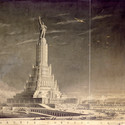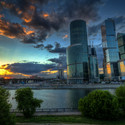In August 1932, Stalin, on vacation in Sochi, sent a note containing his reflections on the inputs the competition to design the Palace of Soviets, the monument never to be built Lenin and central government. In that note, he chose his favorite model, the huge wedding cake topped with a tower of 260 feet (79 meters) high statue of Lenin, designed by Boris Iofan. Just over 80 years later, Sochi again hosted the architectural whims of a powerful Russian leader for the 2014 Winter Olympics in Sochi. A simplistic? Probably. But it's got nice symmetry to it.

.jpg?14040922)

 7
7
The architecture has always been the best way for ideologies to leave their stamp, and Russia is one of the best places in the world to observe it. The last two centuries have seen the transition from Russia not only the forms of government (the tsarist autocracy in the Republic of short duration, then the Soviet system, then back to the Republic), but also the tone of the government, which is just as (if not more) important influencing the architectural heritage of this period. The Russian Revival styles of the 1880s are unthinkable under monarchs over Westernization of only 30 years earlier, and even the Stalinists styles of magnitude have little meaning in the Khrushchev thaw.
In fact, according to Sergei Medvedev, this can be formalized in net 22 periods of Russian culture [1], alternating between what he calls the "vertical" culture and culture "horizontal". The "horizontal" periods are times of relative liberalism, and are characterized by architectural styles that focus on the horizontal: the rigid lines of neoclassicism, the geometric forms of constructivism, and so on. This horizontal aspect of the architecture does not prevent tall buildings as it focuses on space and the human aspect of the architecture; glass and opened constructivism. eras "vertical", meanwhile, are more repressive, and great value, vertical architecture; Gothic influences and neo-Byzantine mid 19th century and of course, Stalinism; the ultimate verticality.
This is, of course, probably not the most useful framework through which to properly analyze or understand the culture Russian, but require an understanding that space is understood very differently in Russia. For example, these aspects of architecture could be extended in a social desire for a more egalitarian society - a horizontal society -. Or greater emphasis on value hierarchies and stability in their vertical cultivation
looking at the planned Palace of Soviets, everything about it is designed to draw the eye toward the top; the long colonnades had their roofs torn off pediments and replaced with steps that mimic the shape of the building, a ziggurat pillars leading to a statue of Lenin exultant gesturing upwards. According to Medvedev, this year looks nothing verticality as the Christ the Savior Cathedral it replaced, completed in 1883 as the largest Orthodox Church in the world. These two buildings are strongly vertical, not only in design but also philosophy; Russian Orthodox Church hierarchy of the late 19th century was a state church which was in contrast Mavericks popular spirituality, and the Palace of Soviets was intended to house not only the representatives of Soviet Russia, but also the organs government; literally people subordinate to the hierarchical government.
is not as ridiculous as it may seem to suggest a link between the two buildings - the Marxist hostility to religion is well known thanks to the popularity of the "opium of the people of the Marx quote, but the early Soviet culture is full of the idea of co-opting of religion, rather than destroying it completely. Communist stars were lifted in place of crosses on the churches, for example, and Sergei Eisenstein, the famous revolutionary filmmaker, went to make a film where the communists looting a church are slaughtered in explicitly religious poses, with their replacing those heads of saints in the icon of the now empty frames. The message is pretty clear: people are the new saints. This is a distinctly anti-hierarchical messages, of course, and it is not surprising that this film was quickly put down by the authorities in the culture "vertical" of the late 1930s - nor is it surprising that the idea people that new saints itself was replaced by portraits of Lenin and Stalin hanging in the style of religious icons.
looking at the contemporary Russian architecture and urban design, then, can feel very well. The palace overlooking the Soviets was, of course, never built - the foundation eventually became a public pool under Khrushchev (a concept which is clearly "horizontal" in the design and purpose), but it also was a rebuilding almost directly from the Christ the Savior Cathedral, consecrated in 00 and quickly used to canonize the last Tsar, Nicolas II, and his family. This not only indicates a tendency to return to architecture and vertical culture, it gives weight to the argument of some researchers, for example Sergey Selyanov [2], who have suggested that the Russian consciousness is based on religious and unique mission, place in the world, which sometimes falls prey to the temptation of those in power to create an imperial state: Peter the Great and European Russia of the 18th and early 19th century built the Church Orthodox, which was considered the last remaining "true" Church after the fall of the Byzantine Orthodox Church and the state; and the Soviet Union in the first co-opted faith and then tried to transcend entirely in favor of a belief in a new bright socialist future. Faith transfers people from the national mission of faith in the state. This goes well with the idea of repressive and liberal architecture, and it also corresponds to events in Russia as Putin is in power.
With diplomatic crises in the Middle East and Eastern Europe and the sanctions resulting in a corner between the West and Russia, and recent legislation for the preservation of "traditional values of the family" and the dramatic improvement in relations between the Russian Orthodox Church and the Kremlin (with 23,000 churches rebuilt under Putin supervision) the events suggest that Putin may well be tempted to resurrect Russia as a unique cultural identity with a national mission. Accordingly, we renaissance architecture of Sochi, using pastel colors and baroque style roofs Peterine Empire as a visual statement of this mission. In parallel, we have supertall skyscraper in the Moscow International Business Center and elsewhere in Russia developed, drawing the eye facades and pointing to the sky. This is of course to take the idea of Medvedev to extreme heights, but in the context of other trends, it could indicate a refocusing on the magnificent and imposing vertical cultivation, as well as playing a role in the wider debate public space in modern developments. In addition to this, the rapid development has been criticized to remake the face of Moscow. This is not the first time that attempts were made to rebuild Moscow, and as such, it is not necessarily a bad thing; many cities have been completely rebuilt. But he speaks of a renewed sense of national self as well as the strong central authority.
the replacement of liberal constructivism - the walls of glass and transparency, broken down barriers and open spaces - with Stalinism was not pure ideology; frankly most constructivist buildings were not designed very well for what they were, but he made a turn herald in the direction of Russia. Is there a similar observable shift in Russian architecture now
[1] Medvedev, S., "Russian history in 22 periods" in Smith, J., In -delà limits: the Concept of space in Russian history and culture, (1999)
[2] Selyanov, S., the Russian idea (1996)
Posting Komentar